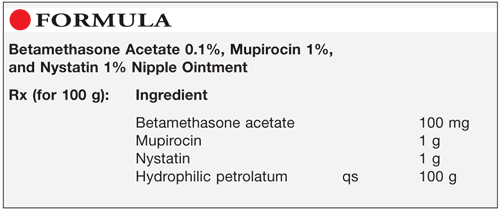US Pharm. 2011;36(6):44-45.

Method of Preparation: Calculate the quantity of each ingredient for the amount to be prepared. Accurately weigh each ingredient. Blend the powders together until they are uniformly mixed. Add a small amount of the vehicle and mix to form a smooth paste. Add sufficient vehicle to final weight and mix well. Package and label.
Use: This preparation has been used for the prevention of infection of cracked nipples, as well as for the treatment of susceptible infections of the nipple and surrounding areas.
Packaging: Package in tight, light-resistant containers.
Labeling: For external use only. Keep out of the reach of children. Discard after ____ (time period).
Stability: A beyond-use date of up to 6 months may be used for this preparation.1
Quality Control: Quality-control assessment can include theoretical weight compared with actual weight, pH, specific gravity, active drug assay, color, texture–surface, texture–spatula spread, appearance, feel, rheologic properties, and physical observations.2
Discussion: Nipple infections may be treated with combination therapy such as the preparation presented here, as well as with a variety of other combinations. The affected area should be thoroughly washed with a mild soap and warm water prior to the application of this ointment each time it is applied. The oleaginous base of this preparation has an emollient effect and can help overcome any skin cracks associated with the nipple infection. This preparation also supplies bacterial action.
Betamethasone acetate (C24H31FO6, MW 434.50) occurs as a white to creamy white, odorless powder. It is practically insoluble in water and soluble in alcohol.1 Betamethasone acetate is used for its anti-inflammatory properties and is available in various dosage forms, including creams and gels.
Mupirocin (C26H44O9, MW 500.62) occurs as a white to off-white, polymorphic crystalline solid. It is freely soluble in dehydrated alcohol, but only very slightly soluble in water. The pH of a freshly prepared saturated solution in water is 3.5 to 4.0. Mupirocin should be protected from light.1,3
Nystatin (C47H75NO17, MW 916.09) is a substance—or a mixture of two or more substances—produced by the growth of Streptomyces noursei (family Streptomycetaceae). It has a potency of not less than 4,400 U/mg. Nystatin occurs as a yellow to light tan, hygroscopic powder with an odor suggestive of cereals. It is affected by long exposure to light, heat, and air, and it is practically insoluble in water and alcohol. Nystatin is a polyene antifungal antibiotic that interferes with cell-membrane permeability of sensitive fungi by sterol binding, chiefly of ergosterol. It works primarily against Candida species and is used topically for the treatment of candidiasis of the skin and mucous membranes.1,3
Hydrophilic petrolatum is an anhydrous absorption base containing cholesterol, stearyl alcohol, white wax, and white petrolatum. It has the ability to absorb water and aqueous solutions. Hydrophilic petrolatum has good emollient effects and occlusiveness. Some similar preparations that may also be used include Aquaphor, Aquabase, Lanaphilic, and others.4
REFERENCES
1. USP Pharmacists’ Pharmacopeia. 2nd ed. Rockville, MD: US Pharmacopeial Convention, Inc; 2008: 775-779,1426,1449,1450.
2. Allen LV Jr. Standard operating procedure for performing physical quality assessment of ointments/creams/gels. IJPC.1998;2:308-309.
3. Sweetman SC, ed. Martindale: The Complete Drug Reference. 37th ed. London, England: Pharmaceutical Press; 2011:329,590.
4. Block LH. Medicated applications. In: Gennaro AR, ed. Remington: The Science and Practice of Pharmacy. 19th ed. Easton, PA: Mack Publishing Company; 1995:1586.
To comment on this article, contact rdavidson@uspharmacist.com.





